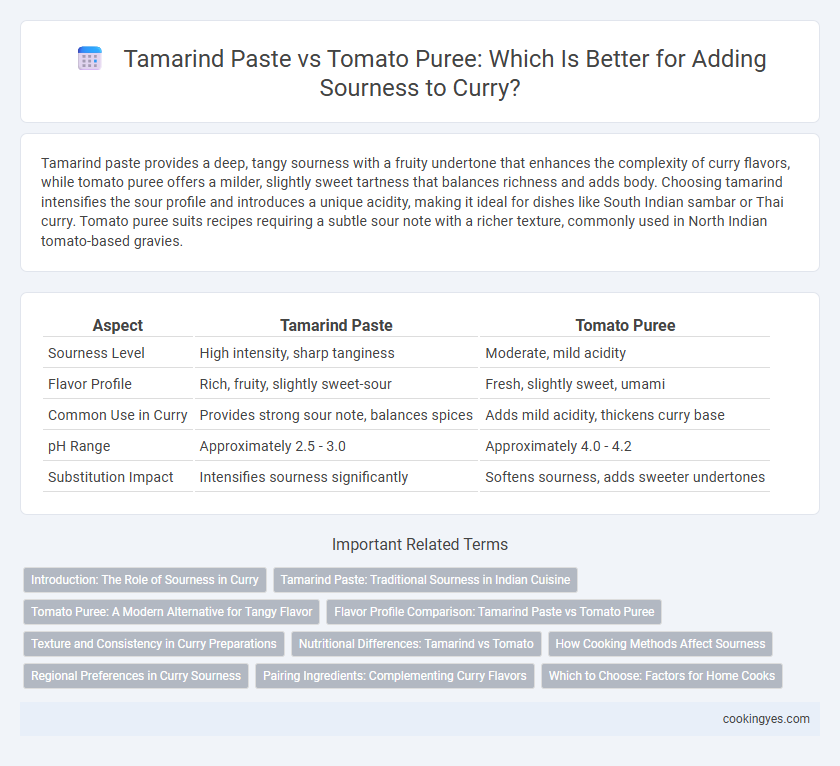Tamarind paste provides a deep, tangy sourness with a fruity undertone that enhances the complexity of curry flavors, while tomato puree offers a milder, slightly sweet tartness that balances richness and adds body. Choosing tamarind intensifies the sour profile and introduces a unique acidity, making it ideal for dishes like South Indian sambar or Thai curry. Tomato puree suits recipes requiring a subtle sour note with a richer texture, commonly used in North Indian tomato-based gravies.
Table of Comparison
| Aspect | Tamarind Paste | Tomato Puree |
|---|---|---|
| Sourness Level | High intensity, sharp tanginess | Moderate, mild acidity |
| Flavor Profile | Rich, fruity, slightly sweet-sour | Fresh, slightly sweet, umami |
| Common Use in Curry | Provides strong sour note, balances spices | Adds mild acidity, thickens curry base |
| pH Range | Approximately 2.5 - 3.0 | Approximately 4.0 - 4.2 |
| Substitution Impact | Intensifies sourness significantly | Softens sourness, adds sweeter undertones |
Introduction: The Role of Sourness in Curry
Tamarind paste provides a rich, tangy sourness with a slightly sweet undertone, enhancing the depth and complexity of curry flavors. Tomato puree delivers a milder acidity combined with natural umami, contributing both sourness and a subtle sweetness that balances spicy and savory elements. Choosing between tamarind paste and tomato puree directly impacts the curry's taste profile, texture, and overall flavor harmony.
Tamarind Paste: Traditional Sourness in Indian Cuisine
Tamarind paste offers a distinctive, tangy sourness essential to authentic Indian curries, providing a complex depth of flavor that tomato puree cannot replicate. Rich in natural acids and subtle fruity undertones, tamarind balances spicy and savory elements, enhancing traditional dishes like sambar and rasam. This souring agent is prized for its ability to deepen the taste profile without the added sweetness found in tomato puree.
Tomato Puree: A Modern Alternative for Tangy Flavor
Tomato puree offers a modern alternative to tamarind paste for achieving sourness in curry, delivering a consistent tangy flavor with a smoother texture. Unlike tamarind paste, tomato puree provides a natural sweetness alongside acidity, enhancing the overall depth of the dish without overpowering other spices. Its wide availability and longer shelf life make tomato puree a convenient choice for home cooks seeking balanced sourness in curries.
Flavor Profile Comparison: Tamarind Paste vs Tomato Puree
Tamarind paste delivers a bold, tangy sourness with fruity undertones, creating a complex and slightly sweet flavor that enhances curry depth. Tomato puree offers a milder acidity with a natural sweetness and umami, providing a subtle sour note that balances richness without overpowering other ingredients. Choosing between these depends on desired sour intensity and flavor complexity, with tamarind intensifying tartness and tomato puree lending a gentle, rounded tang.
Texture and Consistency in Curry Preparations
Tamarind paste offers a smooth, slightly thicker consistency that imparts a rich, tangy sourness ideal for balancing intense spices in curry without watering down the sauce. Tomato puree provides a more liquid texture with a mild acidity, adding subtle sweetness and a vibrant color while contributing to a thinner curry base. Choosing tamarind paste enhances depth and creaminess, whereas tomato puree maintains a lighter, more fluid consistency essential for lighter curry variations.
Nutritional Differences: Tamarind vs Tomato
Tamarind paste provides a natural, tangy sourness rich in antioxidants, dietary fiber, and essential minerals like magnesium and potassium, contributing to improved digestion and heart health. Tomato puree offers a milder acidity with high vitamin C and lycopene content, an antioxidant linked to reduced inflammation and cancer risk. Both ingredients enhance flavor complexity, but tamarind paste delivers a stronger sour profile with additional nutritional benefits, while tomato puree supports immune function and skin health.
How Cooking Methods Affect Sourness
Tamarind paste releases a deeper, more complex sourness when simmered slowly, allowing its natural acids and sugars to meld fully into the curry. Tomato puree offers a brighter, sharper acidity that tends to intensify quickly with heat, often requiring shorter cooking times to maintain its fresh tang. The choice between tamarind paste and tomato puree influences the curry's sour profile, with slow cooking enhancing tamarind's mellow sourness and quick cooking preserving tomato's vibrant sharpness.
Regional Preferences in Curry Sourness
Tamarind paste delivers a distinct tangy sourness favored in South Indian and Thai curries, contributing a deep, fruity acidity that balances rich spices. Tomato puree offers a milder, slightly sweet sourness commonly used in North Indian and Indian street food curries, providing a smoother, less sharp flavor profile. Regional preferences highlight tamarind's prominence in coastal and southern cuisines, while tomato puree remains prevalent in northern and urban curry preparations.
Pairing Ingredients: Complementing Curry Flavors
Tamarind paste offers a tangy, fruity sourness that enhances the depth of curry by complementing spices like cumin, coriander, and mustard seeds. Tomato puree provides a milder acidity with subtle sweetness, pairing well with creamy ingredients such as coconut milk and yogurt. Choosing tamarind paste or tomato puree depends on the desired flavor profile, with tamarind adding sharpness ideal for tamarind-based and tangy curries, while tomato puree balances richer, mellow curries.
Which to Choose: Factors for Home Cooks
Tamarind paste offers a distinct, rich sourness with fruity undertones ideal for authentic Indian and Southeast Asian curries, while tomato puree provides a milder, slightly sweet acidity suitable for Italian and Mediterranean dishes. Home cooks should consider the flavor profile of the dish, with tamarind enhancing complex, layered sour notes and tomato puree offering a more familiar tanginess that complements a wide range of recipes. Texture and color preferences also influence choice, as tamarind paste tends to be thicker and darker, whereas tomato puree is smooth and red, impacting the final appearance of the curry.
Tamarind paste vs Tomato puree for sourness Infographic

 cookingyes.com
cookingyes.com